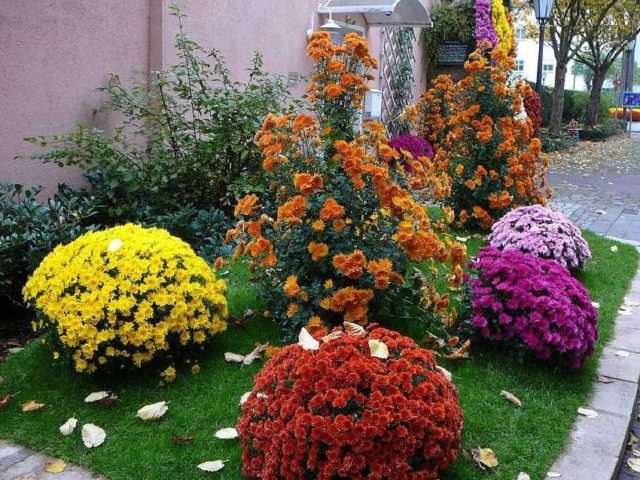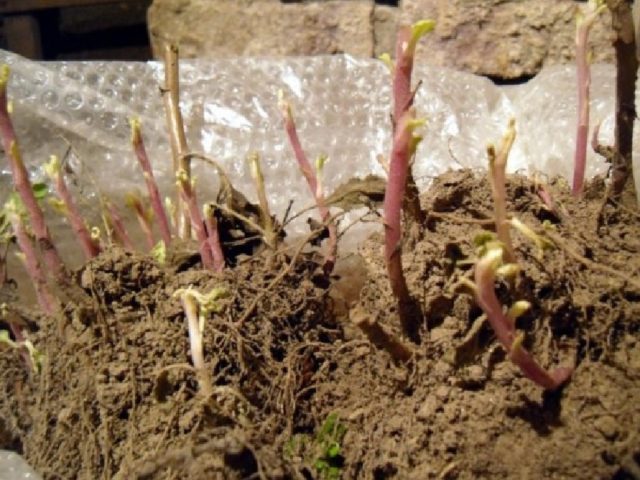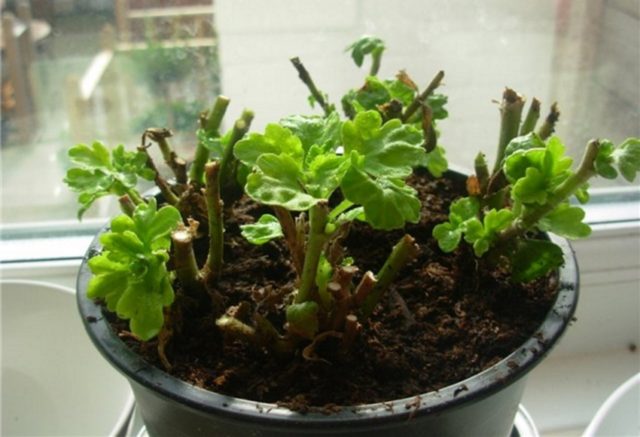Content
Chrysanthemums should be transplanted regularly. The plant belongs to perennials. After a certain time, he needs to change the place, otherwise the intensity of growth and flowering will decrease. It is important for gardeners to know the nuances of autumn and spring transplantation of chrysanthemums so that the bush quickly takes root and blooms.

In order for chrysanthemums to bloom magnificently on the site, the bushes must be transplanted regularly
Features of transplanting chrysanthemums
Perennial transplant equally well in spring or autumn. Young plants (up to 3 years old) must be moved at least once every 2 years. For old bushes, the optimal period is 1 time per year, some gardeners recommend reducing it to six months.
Chrysanthemum transplant at home is needed for:
- increasing or changing the area of planting a flower;
- improving the appearance of the plant.
A feature of the flower is its active growth. During the entire formation process, the bush absorbs a large amount of nutrients, so the transplant saves the plant from nutritional deficiencies.
When to transplant chrysanthemum to another place
Any transplant is stressful for the plant. Therefore, you need to choose a term, taking into account many nuances. For example, the region of cultivation, weather conditions, the condition of the bush, the reasons for transplanting. The main thing is to carry out the procedure not earlier than the moment when stable heat is established.
It is important to consider that the event must be carried out before the chrysanthemum begins to wither due to lack of nutrients. When the soil has become impoverished, further cultivation of the crop in the old place is impractical. The flowers become smaller, the plant loses its decorative effect.
Is it possible to transplant chrysanthemums in spring
Among the main mass of flower growers, spring is considered the best time for transplanting. This is due to the fact that it is easier for the bush to endure stress and recover before the onset of cold weather. She is also the reason - the spring transplant is much easier than at other times of the year. After the snow melts, the soil is soft, moist, pliable. It will not be difficult to dig up a chrysanthemum. In this case, there is no danger of injuring the root system. The roots can be easily removed from soft soil without gusts or damage.
The exact time of transfer should be determined based on climatic features. It is necessary that the threat of recurrent frosts has passed and a stable warm temperature has been established. The procedure is best performed in cloudy weather.
Is it possible to transplant chrysanthemums in the fall
The flower tolerates autumn transplantation well. Many growers prefer to transplant chrysanthemums in October for several reasons:
- In autumn, it is easier to choose a bush with the desired parameters - height, flowering period, color of inflorescences. At this time, all chrysanthemums demonstrate their decorative effect to the fullest.
At the time of flowering, it is easier to choose a variety for transplanting into another composition.
- Annuals have already faded. There is a place for new plants on the flower beds, you can choose a variety of chrysanthemums so that the design is not disturbed.
There are certain rules for an autumn event that a gardener needs to follow:
- Finish the procedure 2-3 weeks before the onset of frost.In the northern regions, it is advisable to transplant the chrysanthemum at the end of September; in the south, you can postpone the date a little until mid-October.
- Do not plant bushes in the fall that were not previously grown in a flower bed. The root system of a flower cannot fully develop in a small container of a pot, therefore it remains underdeveloped and cannot cope with rooting before the onset of winter.
- Choose strong and healthy chrysanthemums for transplanting.
Is it possible to transplant chrysanthemum during flowering
Most often, the autumn procedure occurs at the time of flowering of the culture. Therefore, replanting bushes when they bloom is not prohibited. It is important to choose cloudy weather. The day should be cool, the night temperature is around 0 ° C. It is important to follow all the required rules, then the plant will survive the transplant process well.
How to transplant chrysanthemums correctly
To do this, you need to find out the basic nuances and try to carefully observe them. At the same time, the requirements for the planting process in spring and autumn are the same:
- Competent site selection. For chrysanthemums, you should choose a sunny place with a low groundwater level. Frost is not terrible for a flower, but waterlogging will damage it. If the groundwater is high, then coarse sand should be added during planting.
- Preparation of soil and pits. The soil is needed with a slightly acidic reaction. It is good to apply fertilizer, for example, rotted manure, compost, peat. Dig planting holes 20-22 cm deep.
- Plant preparation. This point is the main difference between spring and autumn transplants. If the event takes place in the spring, then the method of dividing the bush is used. The ground around the plant needs to be moistened. Then carefully dig up the chrysanthemum, being careful not to harm the roots. Divide the mother bush with a sharp knife into several plants. Each part must have a root with shoots. Move the strips to the prepared pits, cover with earth. When planting several chrysanthemums, place the pits at a distance of at least 50 cm. The autumn procedure consists in transplanting a bush with a lump of earth. It is necessary to cut the roots around the bush with a shovel at a distance of 25-30 cm. Moisten the earth, dig out a bush with a lump and transfer it to a new place. Here, pruning of roots plays an important role, which will give new shoots after transplanting. The bush will rejuvenate and the next year will delight you with lush flowering.
Each section must have new shoots for the plant to take root.
- Water the plant. If the soil subsides, add the required amount of soil.
After 3-4 days, it is recommended to feed the chrysanthemum with liquid organic matter, for example, infusion of bird droppings.
Gardeners try to dig up some varieties in the fall and transfer them to the room for the winter. Transplanting chrysanthemums into a pot in the fall also occurs with flowers. The plant needs to be watered, carefully dug out with a lump of earth and transferred to a flower pot. The volume of the container depends on the age and size of the bush.
If a flower was bought or donated at an unsuitable time for transplanting, then it will also have to be moved to a special container until spring. Chrysanthemum transplantation after purchase into a pot is carried out by the transshipment method. It is necessary to prepare a container larger than the previous one, lay a layer of drainage, pour earth. Rearrange the plant and add soil, water.
For flowers that were transplanted into pots in the fall and stored in the basement, preliminary preparation is required. They need to be taken outside and left for 7-10 days to adapt to the ambient temperature. Then transplant in the way described above.
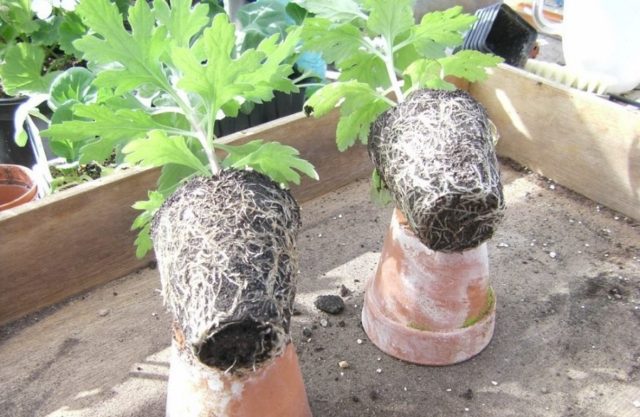
Do not keep garden chrysanthemums in pots for a long time, there is little room for roots in them.
How to transplant indoor chrysanthemums
Indoor plants also require regular replanting. For young chrysanthemums, the pot needs to be changed once a year. Transplant adult plants once every 2-3 years.In this case, it is imperative to look at the condition of the plant. If he needs a transplant, then there is no need to wait 2 years. A slightly larger pot should be taken each time.
Before the procedure, prepare a soil mixture of white sand, humus, garden soil and turf (1: 1: 4: 4). Add 2 tbsp to the mixture. l. dry bird droppings. It is important to ensure that the soil is not acidic. Spill the soil with boiling water, dry it.
Place a drainage layer on the bottom of the pot, fill ½ the volume with soil mixture.
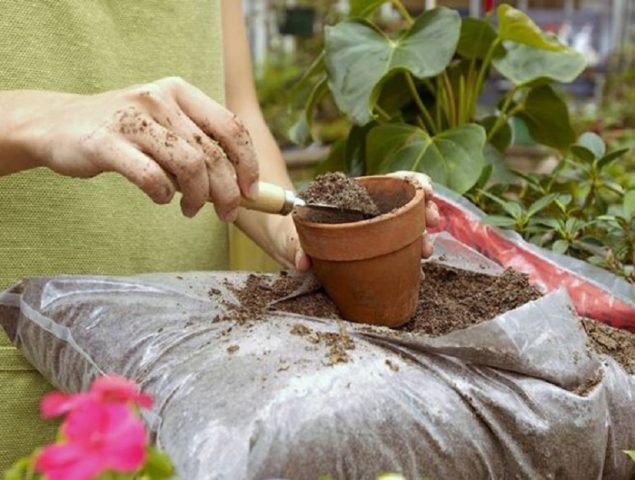
The soil can be prepared by yourself or purchased at the store.
Water the chrysanthemum before transplanting, then carefully remove it from the old pot. Shake off the ground a little, examine the roots. Remove damaged, broken off or rotten ones. Place the plant in a new container, sprinkle with soil mixture, compact slightly and pour over with clean warm water. Put on the west or east window; chrysanthemums may bloom weaker on the south side. They do not like too active sun.
How to transplant chrysanthemum in the garden
A flower that has overwintered in a pot also requires proper transplantation. Being in indoor conditions, the bush cannot immediately adapt on the street. It must be taken out a week before transplanting and placed in the garden. When the chrysanthemum adapts and gets used to the temperature regime, you can start.
Transplanting a chrysanthemum that has wintered in a pot into open ground does not differ from the procedure with garden specimens. You can plant a bush in the place where it grew before or on a new flower bed. If the hole is the same, then you should add wood ash to it before planting and mix with the ground. Then the chrysanthemum will bloom more magnificently. The first feeding is allowed no earlier than 2 weeks later.
How to care for a chrysanthemum after transplant
It is worth considering options for a spring and fall procedure. Bushes planted early in the season will require:
- Watering... The first 2-3 weeks, the soil should be moistened frequently, but without stagnant water. This factor is very important. Chrysanthemums cannot stand waterlogging. Then it is necessary to water the bush as the soil dries, trying to pour water into the root zone. The frequency of the procedure depends on weather conditions and soil structure.
- Top dressing... You can feed the transplanted chrysanthemum for the first time in 3-4 days. The main components are nitrogen and phosphorus. The culture responds well to feeding with infusion of bird droppings. Complex fertilizer for flowers can replace it.
- Weeding... It is necessary to remove weeds, especially the first time after transplanting. This will help the root system get enough moisture and nutrients to take root.
If the chrysanthemum is transplanted in the fall, it will need winter preparation. Chrysanthemums must be protected from getting wet:
- When persistent cold weather sets in, cut the bush to a height of 10 cm from the ground.
- Spud the plant. In this case, it is important to ensure that the surrounding surface is flat. If pits remain, then there will be an accumulation of water in them, which will lead to decay of the root system. This measure of protection is sufficient for regions with heavy snow, which lasts until spring. If thaws are often repeated on the site, then chrysanthemums need additional protection. Lay out a brick fence around the bush, on which to place boards or slate pieces. This design will not allow the roots to get wet, and the ground will provide ventilation.
- Top with spruce branches, twigs or leaves. The shelter will need to be removed in the spring after the snow melts and the above-zero temperature stabilizes.
If all the points are done correctly, then next year your favorite flowers will bloom magnificently again.

Competent transplantation guarantees a high decorative effect of the culture
Useful Tips
Experienced growers always have a few secrets to help grow luxurious chrysanthemums. They will be useful to everyone who is going to transplant a bush on their site:
- If a variety is purchased in the fall, the frost resistance of which is unknown, then it is better to transplant the chrysanthemum into a pot for the winter.The plant will survive well for several months in the basement, and in the spring it can be planted outside. You should also do with chrysanthemum purchased in the fall in a pot. The bush will not have time to take root before the onset of winter and may die. Before sending to the basement, you need to cut the stems to a height of 15 cm, and wrap the container in cloth. This will save the culture from premature germination. In spring, move to a bright and warm place, wait for shoots to appear and transplant.
When kept in a pot near a garden plant, the stems must be cut
- When transplanting tall chrysanthemums, you need to immediately take care of the support.
- The culture reproduces well by cuttings. If for some reason it was not possible to transplant the chrysanthemum from the street, you can plant a cutting.
- The infusion of chicken manure must be diluted with water in a ratio of 1:10 before making it.
- Chrysanthemum transplants should be done regularly, otherwise the flowering becomes unattractive due to the smaller flowers.
- In the hot season, it is recommended to spray the plant with water. Especially if it grows in the room.
Simple tips will help to grow a luxurious chrysanthemum even for novice flower growers.
Conclusion
Transplanting chrysanthemums is not difficult at all. This event is required to be held regularly. Therefore, you need to carefully study the entire process so that the transplant takes place without problems, both in spring and autumn.
